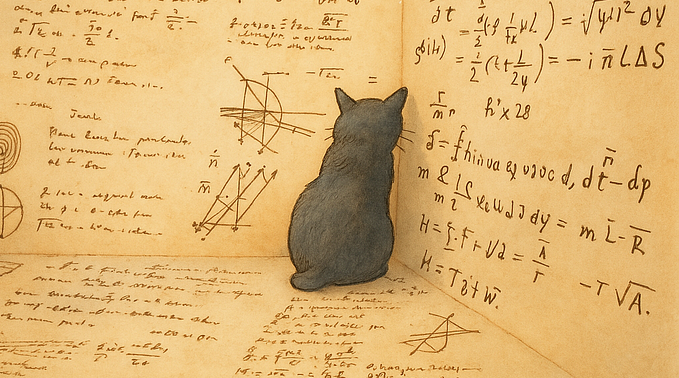
Celebrating the Cycloid
I recently discovered a new shape — the cycloid. Never heard of it? Now’s your chance to learn along with me and be amazed.
[NOTE: This post isn’t as long as it looks. There are lots of pictures.]
It’s not very often that you discover a new shape. I think most of us assume our knowledge of shapes has been covered for some time. We know our squares, circles, and triangles from elementary school along with later high school additions of parabolas, ellipses, and sine curves. But nobody learns a new shape in the their 30's, right? Wrong!
I recently discovered a new and fascinating shape: the cycloid. Yes, you read that correctly — a new shape. For this blog, I aimed to introduce myself (and my handful of readers) to this shape. It ended up being way more fun (and nerdier) than I expected. 🧠 🤙
What is a cycloid?
According to Wikipedia, a cycloid is defined as “the curve traced by a point on a circle as it rolls along a straight line without slipping.” Perhaps it’s easier to visualize with the following animated gif:

The cycloid is the red curve traced by the point on the outside of the circle as it rolls along on the line. That’s it — that’s a cycloid. Simple, right? Wrong again.
History of the Cycloid
The cycloid is sometimes called “The Helen of Geometers” because it has caused so many quarrels over the years amongst mathematicians. One argument is around who discovered the shape. The oldest cited candidate is Pythagoras’ biographer Iamblichus (c. 245 CE – c. 325 CE). Others credited are a slew of polymaths including German Nicholas of Cusa (1401–1464), Frenchman Charles de Bovelles (1475–1566), Italian Galileo Galilei (1564–1642), and Frenchman Marin Mersenne (1588–1648). No one knows for sure who deserves the recognition.

I’m guessing most people are like me and have only heard of Galileo, who it turns out was the first person to earnestly study cycloids and gave them their name. He went so far as to build models of cycloids from sheet metal in an attempt to understand the area under the cycloid’s curve. He probably could have benefitted from calculus. Evangelista Torricelli (1608–1647), who invented the mercury barometer, is credit with eventually correctly solving for the area under one arc of the cycloid BTW.
Over time cycloids have attracted a who’s-who of famous mathematicians including René Descartes (1596–1650), Pierre de Fermat (1607–1626), Blaise Pascal (1623–1662), Isaac Newton (1642–1726), Gottfried Leibniz (1646–1716), Guillaume de l’Hôpital (1661–1704), Johann Bernoulli (1667–1748), Leonhard Euler (1707–1783), and Joseph Louis Lagrange (1736–1813). Those are certainly names I recognize.
They apparently liked to create contests and problems related to cycloids that ended in fights and name-calling. For example, Pascal created a contest to calculate the (1) center of gravity, (2) area, and (3) volume of the cycloid with Spanish gold as a prize. Three judges deemed that no one won, which doesn’t sound very fun. Christopher Wren (1632–1723), the famed designer of St. Paul’s cathedral in London, submitted a proof for determining a cycloid’s length during the contest— which wasn’t really one of the contest’s questions but still pretty cool. A contest judges claimed he’d already solved that problem years earlier but never written it down. This led to public fighting. Even less fun. (Wren published his work and got the credit FWIW.)
Another math challenge was proposed by Bernoulli in 1696 that ended with pettiness, but we’ll hear more on that later.
Getting to know cycloids with some math
Now that we’re acquainted with cycloid history, you might be asking yourself the same geometry questions as our dead mathematician friends Galileo and Wren: What’s the area under a cycloid? How long is a cycloid’s path? In other words, tell me about this shape, dude.
We (luckily) have the math (and YouTube) to help us.
There are parametric equations that plot a cycloid’s path relative to time (t) as a circle rolls forward on an x-and-y axis. I found this YouTube derivation particularly helpful for visualizing its sinusoidal nature. There are two equations because the x and y positions are independent of each other:
- x(t) = r(t−sin(t))
- y(t) = r(1−cos(t))
To see these equations in action, let’s imagine that t = π. At this point, x(π) = r(π−sin(π)). Since sin(π) = 0, then x(π) = πr. This is halfway through the circle’s roll since the circumference that the circle will roll is 2πr. The height will be y(π) = r(1−cos(π)). Since cos(π) = -1, then r(1-(-1))=2 and y(π) = 2r. This makes sense since our point on the circle will be at its highest point halfway through the roll, two full radii above the line.
Now that we have equations, we can use calculus to find the area and length of the cycloid. Yes, I challenged myself to do the math (with some major YouTube and Google assists). I had flashbacks of trigonometry and AP Calculus with half angle identities and integrals. Here’s my work, tastefully done with multiple marker colors:

Like most things involving circles, the solutions are simple. The area under a cycloid is 3πr². Amazingly, Galileo came extremely close to the 3:1 ratio between the area of cycloid (3πr²) and the area of a circle (πr²) using the super old-school sheet metal method mentioned earlier. The length of the cycloid is just 8r. That’s the answer Wren got earlier too. No π’s or anything in that solution.
Honestly, those are kind of beautiful answers. 😘
Cycloids in physics
Apart from their elegance, are cycloids useful? Do they appear anywhere in nature? While not rising to the heights of some of its geometric kinsmen, cycloids make some amazing appearances in the natural world.
We’ll return to Bernoulli’s 1696 math challenge. Here’s how he posed his problem to the leading mathematicians of the day:
I, Johann Bernoulli, address the most brilliant mathematicians in the world. Nothing is more attractive to intelligent people than an honest, challenging problem, whose possible solution will bestow fame and remain as a lasting monument. Following the example set by Pascal, Fermat, etc., I hope to gain the gratitude of the whole scientific community by placing before the finest mathematicians of our time a problem which will test their methods and the strength of their intellect. If someone communicates to me the solution of the proposed problem, I shall publicly declare him worthy of praise.
The man wasn’t afraid to talk a big game — although the whole “I shall publicly declare him worthy of praise” seems less interesting than Spanish gold and more than a little sexist. Bernoulli then posed his challenge:
Given two points A and B in a vertical plane, what is the curve traced out by a point acted on only by gravity, which starts at A and reaches B in the shortest time.
In other words, if a marble were traveling from a higher point to a lower point along a curve (and assuming the points are not directly below each other), what path should the marble take to complete the journey in the shortest time? This assumes the marble travels in a frictionless plane with a uniform gravitational field.
Bernoulli’s prize of “praise” is even more funny considering he incorrectly derived a correct solution to this problem and then plagiarized the correct derivation from his brother. Yikes.
Bernoulli gave six months for people to submit solutions, but no one did. Leibniz advocated to have the submission period extended for a year and a half. It’s during this extended period that Isaac Newton heard about the problem. He reportedly found the challenge in a letter from Johann Bernoulli at 4:00 p.m. when he arrived home from the Royal Mint on January 29, 1697. He stayed up all night and mailed a correct solution anonymously the next day. The solution was apparently so good and so clearly Newton’s that Bernoulli identified him as one “recognizes a lion from his claw mark.” 🐅
Newton’s single-evening solution crushed the two weeks it took Bernoulli to solve the problem. Then, in mathematician mic drop fashion, Newton threw some spice in his letter, “I do not love to be dunned [pestered] and teased by foreigners about mathematical things…” Newton was never known for being the most pleasant person. Savage.

This fastest path solution Newton and Bernoulli found is something called a brachistochrone curve, which translates to ‘shortest time’ in Greek. As you may have guessed by the subject of this blog, a brachistochrone curve is part of the path of a cycloid. Below is a video I discovered on Instagram showing this curve in action. This is also how I encountered cycloids:

That’s amazingly cool. It’s always fun to see the power of shapes in nature.
Another fun curve that is part of a cycloid’s repertoire is the tautochrone curve, which means “same time” in Greek. You can place a marble anywhere on this curve and it will take the same amount of time for it to roll to the bottom. It is also based on a half of a cycloid. Here’s that curve in action:

There’s also something called a cycloidal pendulum. Imagine you placed a pendulum’s end at the meeting point of two inverted cycloids. If you swung the pendulum, the string would bend against the cycloids throughout its sweeping path. The shape the end of the pendulum traces is ANOTHER FREAKIN’ CYCLOID. 🤯

There are tons of variations you can make with rolling circle cycloids too. You could roll a circle forward, but instead track a point inside or outside the circle’s perimeter to create curlier or flatter curves. An visualization of each is captured in the image below:

You can also roll circles and shapes on other circles and shapes to expand the cycloid family as we’ll see later.
Finally you can create a cycloid in physics this very moment by dropping something from any height. The object’s movement to the earth would be a line straight downward. Because the earth (a circle) rotates a little on the way down, the path the falling object will travel is very slightly inverted cycloid (albeit a really tiny one)!²
Cycloids in literature
Cycloids must have been quite the rage because they appeared in literature occasionally in previous centuries. While I won’t document all the cases, here’s one from Herman Melville’s 1851 classic Moby Dick:
It was in the left hand try-pot of the Pequod, with the soapstone diligently circling round me, that I was first indirectly struck by the remarkable fact, that in geometry all bodies gliding along the cycloid, my soapstone for example, will descend from any point in precisely the same time.
Cycloids in architecture
Now that we’re all agreed cycloids are amazingly cool, I started wondering if I’ve missed cycloids anywhere else in everyday life.
Architecture is full of geometric shapes. Many of the best known arch types are based on circles (Roman arch), ellipses (semi-elliptical arch), parabolas (parabolic arch), and catenaries (catenary arch). There are myriad examples of each, but I pulled some well known ones below:




A cycloid looks a lot like an arch. So are cycloid arches used in architecture? According to my internet research, they are — but rarely. There are two prime examples that come up repeatedly (largely from their inclusion on the Wikipedia page for cycloids).
The first is the roof of the Kimbell Art Museum in Fort Worth, Texas. The multiple arches of this roof are a series of cycloids with a small space in between. This gives the soothing appearance of a wheel rolling. I dig it. Great choice for an art museum.

The second instance of a cycloid arch in architectural design made me do a double-take. There are cycloid arches on the facade of the Hopkins Center at Dartmouth College in Hanover, NH. Dartmouth is where I studied for undergrad, so I literally saw this shape every day for 4 years. Maybe that’s why I’m so drawn to it?

It turns out that our alumni magazine highlighted the Hop’s cycloid arches as one of the 101 reasons to love Dartmouth back in 2016. I couldn’t help myself and reached out for more information. So far, I haven’t heard anything substantial back:

Cycloids in art and leisure
You probably played with cycloids as a kid too. Hasbro’s Spirograph toy which has been manufactured since the mid 1960’s is based on a modified form of cycloids called hypocycloids. Rather than rolling a circle on a line, a hypocycloid is “a special plane curve generated by the trace of a fixed point on a small circle that rolls within a larger circle.”

Two special forms of a hypocycloid are the deltoid and astroid. You can make these shape by rolling a circle inside another large circle with three and four times its radius respectively:


You’ve likely seen these shapes before.
There are three astroids of different colors in the logo of the Pittsburgh Steelers football team (cycloids continue hitting close to home for me!).

And the deltoid is the base shape for Dodge’s “Fratzog” logo, which it used from 1962 to 1976. The fratzog will be the logo again for its upcoming electric muscle car series.

If you find these shapes soothing, there are a number of artists who make cycloid art like the one shown below be incorporating multiple rolling circles of different sizes into their design:


Cycloids in optics
You can roll circles on the outside of other circles too and trace their path to make additional derivations of cycloids. One special case of this category is a cardioid. It is the shape created by tracing a point on the edge of a circle rolling on the outside of another circle with the same radius. The path of this cycloid has exactly one cusp as shown below and resembles a heart (which is where it gets its name):

Cardioids appear in nature all the time, particularly in the caustics created from two circular surfaces. In optics a caustic is defined as “the envelope of light rays reflected or refracted by a curved surface or object, or the projection of that envelope of rays on another surface. The caustic is a curve or surface to which each of the light rays is tangent, defining a boundary of an envelope of rays as a curve of concentrated light.”
We see cardioids in caustics created by multiple circular objects ranging from coffee cups to watches.


Keep your eyes open for this shape next time you’re sitting down for a cup of tea in the morning! ☕️
The boundary of the central region of the Mandelbrot set (of fractal geometry and chaos theory fame) is also a precise cardioid. I don’t really understand how or why, but it’s a cardioid making another appearance. Noice. 👍

Cycloidal shapes aren’t limited to just circles. You can also roll non-circular shapes on other shapes and introduce yourself to a whole new range of shapes called cyclogons. For example, here’s a cyclogon for rolling a triangle and square on a line:


Cycloids in space
Viewing cycloidal phenomenon isn’t limited to the micro-scale of rolling wheels, watches, teacups, and Spirographs. They’re also visible at a planetary level. Because Jupiter’s moon Europa (a smaller circle) orbits the large planet (a larger circle) gravitational forces (a line) exerted on the moon’s surface are cycloidal. The cycloid shape is visible in Europa’s cracking ice surfaces from satellite images. The cracking corresponds to the moon’s orbital path around Jupiter and its resulting gravitational pressure.


Summary
Was this another geek-fest of a blog post? Certainly. But hopefully you learned something about a new shape that you’re either discovering for the first time like me or learning more about. In fact, since cycloids are actually a whole grouping of cool shapes, I ended up learning about like 20 new shapes ranging from brachistochrone curves to deltoids to cyclogons.
How cool is it to discover new shapes when you’re in your thirties?
Makes me want to look at the universe around me with a little more curiosity and wonder…

¹ Eli, Maor and Eugen Jost. “Twisted Math and Beautiful Geometry.” American Scientist.
² Lynch, Peter. “The curved history of cycloids, from Galileo to cycle gears.” The Irish Times. 17-Sep-2015.








